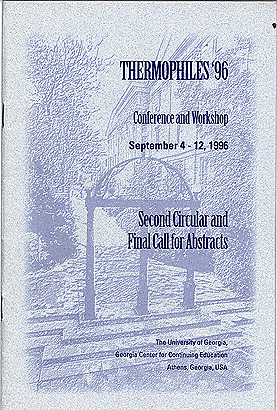Heat And Cold Shock Effects On Dna Topology From Hyperthermophilic Archaeal Plasmids
This is a poster put on the Thermophiles '96 Conference and Workshop, September 2-4 , 1996, Athens, Georgia,USA.

Heat And Cold Shock Effects On Dna Topology From Hyperthermophilic Archaeal PlasmidsThis is a poster put on the Thermophiles '96 Conference and Workshop, September 2-4 , 1996, Athens, Georgia,USA. | 
|
See an overview of the poster
Here's the abstract (in text format):
Heat and Cold Shock Effects on DNA Topology from Hyperthermophilic Archaeal PlasmidsP. López-García and P. ForterreInstitut de génétique et Microbiologie, Université Paris-Sud, 91405 Orsay Cedex, France.The discovery of the unique enzyme, reverse gyrase, in hyperthermophiles, led to the subsequent finding of a substantially different topological state for DNA in these organisms. First, the sulfolobal viral SSV1 genome was found to be positively supercoiled (at least after UV induction), and later on, the plasmid pGT5 from Pyrococcus abyssi was shown to be relaxed at physiological growth temperature. Recently, we have also shown that plasmids extracted from new isolated thermococcal and sulfolobal strains are from relaxed to actually positively supercoiled. This contrasts with the negatively supercoiled state of DNA molecules in mesophiles, either bacteria, archaea or eucaryotes. Modification of DNA topology as a function of physical parameters has been claimed to be one of the means by which mesophilic bacteria adjust their pattern of gene expression to varying environments. In particular, changes of the linking number (Lk) of reporter plasmids have been correlated with temperature shifts. Heat shock seems to be related with a transient increase in plasmid Lk in the few bacteria tested, and Lk increases as well with growth temperature. In contrast, a decrease in growth temperature seems to be correlated with either a decrease or an increase in Lk depending on the species analyzed, and by the moment, there are not clear data available concerning the topological effect of a cold shock in these plasmids. In order to address DNA topological dynamics in hyperthermophiles, we have analyzed the topological changes of different plasmids from Sulfolobales after heat and cold shock. A cold shock from 80*C (optimal growth temperature) to 65*C triggered an identical response in all sulfolobal plasmids used in this analysis. The Lk decreased to reach approximately the same low values that are observed when cells are directly grown at 65*C (more or less relaxed), and is kept constant after 24 hours. On the contrary, the effect of a heat shock from 80*C to 85*C was different depending on the strains analyzed. pRN1 and pRN2 from Sulfolobus islandicus REN1 H1, as well as p59/2 from Sulfolobus sp. NZ59/2, increased their Lk, reaching high levels of positive supercoiling between 1-2 h after the temperature shift. Afterwards, Lk decreased to lower levels of positive supercoiling, although not as much as to reach reference (80*C) levels. p54/3 from Sulfolobus sp. NZ54/3 experienced also a high increase in positive supercoiling, that was kept constant. Transient variations in Lk induced by heat shock could mediate the stress response allowing the differential expression of certain genes charged of re-establish homeostasis. Stable Lk values reached after cold and heat shocks correspond probably to the most adapted topologies for correct gene expression under new conditions. |
Here is an overview of the poster as it was setup during the congress. Click on individual panes to view panels in full size:
Here is text version for those who don't read maps.
Poster Title
Introduction #1
Introduction #2
Material & Methods #1
Material & Methods #2
Material & Methods #3
Results & Discussion #1
Results & Discussion #2
Cold Shock
Conclusion
References
Table 1
Figure 1 Legend
Figure 1 A
Figure 1 B
Figure 2 Legend
Figure 2
|
|















|